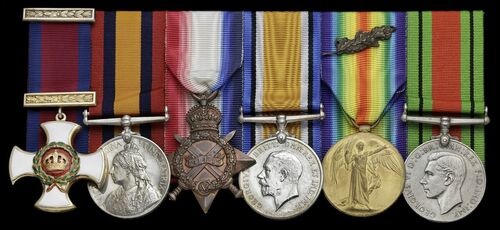
Auction: 23001 - Orders, Decorations and Medals
Lot: 321
(x) The 'Second Battle of Heligoland Bight' D.S.O. group of six awarded to Engineer Captain J. B. Nicholson, Royal Navy, who had previously received a 'mention' for his services with H.M.S. Royalist at the Battle of Jutland, and was later to serve as an A.R.P. Warden during the Second World War
Distinguished Service Order, G.V.R., silver-gilt and enamel, with integral top riband bar; Queen’s South Africa 1899-1902, no clasp (Ast. Engr. J. B. Nicholson. R.N. H.M.S. Sappho.); 1914-15 Star (Eng. Lt. Dr [sic]. J. B. Nicholson, R.N.); British War and Victory Medals, with M.I.D. oak leaves (Eng. Commr. J. B. Nicholson. R.N.); Defence Medal 1939-45, contact mark to second, otherwise nearly extremely fine (6)
D.S.O. London Gazette 27 June 1919, the original recommendation states:
'Eng. Cdr. Nicholson has constantly performed his duties with great efficiency. On the 17 November 1917 the ship had been less than 3 days out of dockyard hands, and I consider it is due to this Officer's professional ability and painstaking attention to details on this, and all other occasions that the ship maintained a speed of at least 28 knots for a prolonged period and kept station on "Caledon" throughout the action.'
James Bell Nicholson was born at Richmond, Surrey on 12 December 1876, the son of George and Elizabeth Nicholson. His father was a naturalist and curator of Kew Gardens; the young Nicholson was educated at King's College London and later Keyham College where he earned a 1st Class Certificate in Engineering. Joining the Royal Navy with the rank of Assistant Engineer on 1 July 1899 Nicholson was serving in that rank with H.M.S. Sappho during her service during the Boer War in 1901. Promoted Engineer Sub-Lieutenant he was further advanced to the rank of Engineer-Lieutenant on 1 July 1903.
Accepted as a member of the Institute of Mechanical Engineers on 23 March 1907 whilst still Engineer-Lieutenant, Nicholson was married later that year (12 September) to Ella Astbury at St. Mary's Church, Mortlake. Promoted Engineer Lieutenant-Commander prior to the outbreak of the Great War, the Battle of Jutland on 31 May found him serving with H.M.S. Royalist as part of the 4th Light Cruiser Squadron under Commodore Le Mesurier.
During the battle they served initially as an anti-submarine screen for the Grand Fleet; later they engaged the German destroyer screen and the squadron leader, H.M.S. Calliope, launched a torpedo attack towards the main German Fleet before they withdrew back towards the British line. Nicholson received a 'mention' for his actions during the battle, during which Royalist performed well.
Transferring to the 1st Light Cruiser Squadron in August 1917, Royalist was present for the Second Battle of Heligoland Bight: a 'test trip' by a German Fleet, attempting to find a way through British minefields around Heligoland Bight, was detected by the British codebreakers of Room 40. As with Jutland the action opened with the two fleets escort screens, Royalist taking her place in formation next to the light cruiser Caledon. As the German battlecruisers came into range Caledon took a shell to the forward turret, causing heavy damage and forcing the squadron to withdraw under covering fire from the battlecruiser Repulse.
It was for this action that Nicholson was awarded the D.S.O. and later promoted Engineer-Captain. Retiring from the military, his son - John Astbury Nicholson - continued family tradition by joining the Royal Naval Reserve. On the outbreak of the Second World War, Nicholson senior took on the role of A.R.P. Warden for his local town of Saltash. A tribute to his efforts was reported in The Guardian and Gazette on 19 April 1945, which states:
'The Mayor, in making the presentation said that Capt. Nicholson's past career as an officer in the Royal Navy and his experience and knowledge of staff control, had proved a great asset. He felt sure they would be doing Capt. Nicholson less than justice if they passed on without comment his devotion to duty and unfailing courtesy to everyone.'
It was during his work as a Warden that personal tragedy struck, as his son (now Lieutenant Nicholson R.N.V.R.) was killed in action whilst serving aboard the trawler H.M.S. Alouette on 19 September 1942. This vessel was torpedoed by U-552 off Sesimbra, Portugal - as part of the aft was still afloat after the first strike, a second torpedo was fired into the starboard side of the trawler, which sank immediately. At the time, Nicholson was described as a member of scientific staff with R.R.S. Discovery 11 which implies he either saw work on arctic research or war duty with Discovery 11 as a R.F.A. vessel.
Nicholson senior died at Saltash, Cornwall on 9 March 1952; sold together with an original slip of issue for the Defence Medal named to 'Engr. Capt. J. B. Nicholson' and a handwritten service record, as well as copied research comprising I.O.M.E. proposal form, recommendations, London Gazette, Guardian and Gazette and War Supplement extracts as well as medal rolls and a Commonwealth War Graves certificate for Lieutenant J. A. Nicholson.
Subject to 5% tax on Hammer Price in addition to 20% VAT on Buyer’s Premium.
Sold for
£1,900
Starting price
£800




